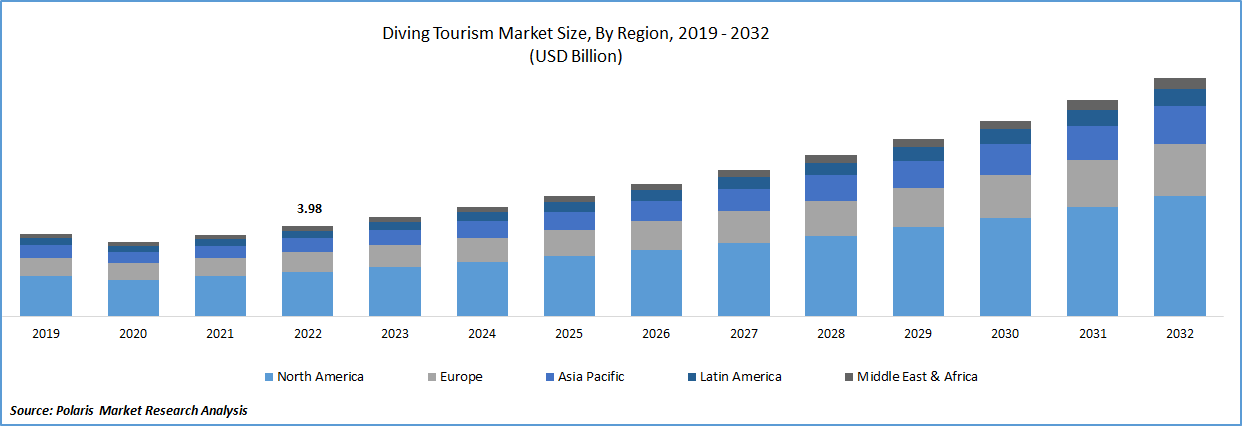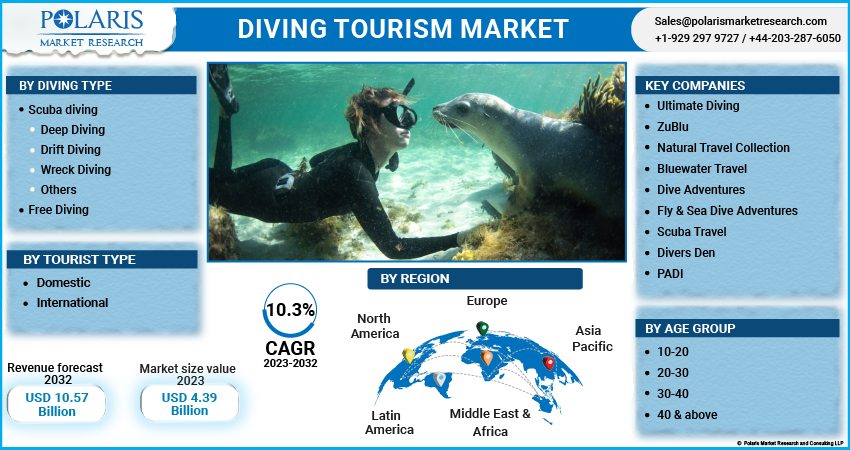
Diving Tourism Market Share, Size, Trends, Industry Analysis Report
By Diving Type (Scuba Diving and Free Diving); By Tourist Type; By Age Group; By Gender; By Region, And Segment Forecasts, 2023 - 2032
- Published Date:Jul-2023
- Pages: 118
- Format: PDF
- Report ID: PM3619
- Base Year: 2022
- Historical Data: 2019-2021
Report Outlook
The global diving tourism market was valued at USD 3.98 billion in 2022 and is expected to grow at a CAGR of 10.3% during the forecast period. As disposable incomes rise in emerging markets, more people can afford leisure activities such as scuba diving. This has led to an increase in demand for diving services and equipment, and the growth of the middle class in these markets is expected to continue driving this trend. As a result, the scuba diving industry has been expanding in emerging markets, with new dive centers, resorts, and training facilities being established to meet the growing demand. This presents opportunities for businesses in the scuba diving industry to expand into emerging markets and capitalize on this trend.

To Understand More About this Research: Request a Free Sample Report
The increasing awareness of marine conservation has played a significant role in the growth of sustainable diving tourism. Many scuba divers today are keenly aware of the fragility of marine ecosystems and the impact that diving activities can have on them. As a result, there has been a growing demand for environmentally responsible diving practices that minimize the impact on marine life and ecosystems.
Several organizations such as The MarineBio Conservation Society, Marine Conservation Institute, and Oceana have been instrumental in raising awareness about the importance of marine conservation and advocating for sustainable diving practices. In addition, many dive operators and resorts have also taken steps to promote sustainable diving tourism by adopting eco-friendly practices, such as reducing plastic waste, using renewable energy sources, and supporting local conservation efforts.
Sustainable diving tourism not only benefits the environment but also provides economic benefits to local communities. By supporting local conservation efforts and promoting sustainable tourism practices, dive operators and resorts can attract eco-conscious travelers and contribute to the growth of the local economy. Overall, the focus on marine conservation has led to a more responsible and sustainable scuba diving industry, which is good for both the environment and the economy.
With travel restrictions and lockdowns implemented in many countries to control the spread of the virus, the demand for scuba diving and other leisure activities decreased substantially. As a result, many dive centers, resorts, and liveaboards were forced to close temporarily or permanently due to the decline in business. However, as the situation has started to stabilize and vaccination campaigns have been rolled out in many countries, the scuba diving industry is slowly recovering. With the easing of travel restrictions and the resumption of international travel, there has been a gradual increase in demand for scuba diving services and equipment.

For Specific Research Requirements, Speak to Research Analyst
Industry Dynamics
Growth Drivers
The growth of the diving tourism market is also likely to be driven by the increasing awareness of the importance of ocean conservation and the adoption of sustainable practices by governments and organizations around the world. This is likely to result in more regulations and standards for the scuba diving industry, which will further drive the adoption of sustainable and responsible practices.
By adopting sustainable and responsible tourism practices, businesses in the scuba diving industry can not only contribute to the protection of the oceans but also ensure long-term growth of the market. Consumers are increasingly prioritizing sustainability and environmental responsibility, and this trend is expected to continue in the future. Businesses that prioritize sustainability can attract eco-conscious travelers who are willing to pay a premium for environmentally responsible tourism experiences. This can help to differentiate their business from competitors and improve their profitability in the long run. In addition, sustainable tourism practices can help to preserve the natural beauty and biodiversity of dive sites, ensuring that they remain attractive to tourists for years to come.
Report Segmentation
The market is primarily segmented based on diving tourism, tourist type, age group, and region.
|
By Diving Type |
By Tourist Type |
By Age Group |
By Region |
|
|
|
|
To Understand the Scope of this Report: Speak to Analyst
Scuba diving segment accounted for the largest market share in 2022
Scuba diving garnered the largest share. The development of new technologies has made scuba diving more accessible, safer, and easier for people to take up the sport. Modern scuba diving equipment, such as buoyancy control devices, dive computers, and high-quality wetsuits, has significantly improved the diving experience for both beginners and experienced divers. Moreover, there have been significant advancements in diving safety technology, such as dive location beacons, communication systems, and emergency oxygen supply, which have made scuba diving much safer. These technologies have enabled divers to communicate more effectively and receive prompt assistance in the event of an emergency.
According to estimates by PurpleOrca Media Ltd in 2021, the United States had approximately 2.6 million active scuba divers. The number of scuba divers in the country is expected to increase in the coming years, driven by several factors such as the growing popularity of the sport and an increasing number of certification courses offered by various service providers. One of the leading service providers in the scuba diving industry is the Professional Association of Diving Instructors (PADI), which offers scuba diving courses, training, and certification programs for beginners and experienced divers
30-40 Age Group is expected to hold the significant revenue share over the forecast period
30-40 age group held the significant share. People in their 30s and 40s often have more disposable income to spend on leisure activities such as scuba diving. This age group is typically more financially stable and may have fewer financial obligations than younger individuals, such as student loans or childcare expenses. As a result, they may have more flexibility in their spending and be more willing to invest in hobbies and activities that they enjoy.
20-30 segment registered the steady growth. Scuba diving can be an exciting experience that requires physical endurance and mental focus. It allows individuals to explore the under-water to witness the beauty of marine life up closer, which can be a transformative and awe-inspiring experience. Scuba diving can also provide a sense of adventure and excitement, as individuals venture into unknown waters and encounter new challenges.
International segment expected to hold the significant revenue share
International tourist held the significant share. Segment is driven by the availability of unique & exotic dive sites, and the opportunity to connect with nature. Scuba divers often seek out unique and exotic dive sites that offer opportunities to witness rare and stunning marine life, such as vibrant coral reefs, large schools of fish, and unique underwater landscapes. These dive sites can be found all around the world, from the Great Barrier Reef in Australia to the coral reefs of the Caribbean and the Red Sea in Egypt.
Domestic segment registered the steady growth rate. Segment’s growth is attributed to the increasing popularity of adventure sports and outdoor activities among residents. Domestic diving tourism allows individuals to explore the underwater world in their own country, which can be a more affordable and accessible option than traveling abroad for a diving vacation.
North American demand is projected to expand significantly.
North America held the largest share. The growth of the adventure and eco-tourism industries in the U.S. Many consumers are seeking experiences that allow them to connect with nature and explore the world in a more meaningful way, and diving offers a unique way to do so. Demand for diving experiences is likely to increase as well. This has led to the creation of new businesses and dive operators offering diving packages in popular dive destinations such as Florida, Hawaii, & California.
Furthermore, the availability of diving infrastructure and services such as certification courses, equipment rentals, and diving tours has made diving more accessible and attractive to both domestic and international tourists. Rising dive operators & tour companies offering packages in the U.S. also indicates a growing interest in diving tourism among travelers.
Europe is grown exponentially in the global market over the forecast period. Europe's coastline offers a variety of attractive destinations for diving tourism, including popular places such as Gozo Island, Losinj (Croatia), Tenerife (Spain), Pembrokeshire (U.K), and Brac (Croatia). These destinations are known for their clear waters, diverse marine life, and unique underwater topography, such as wrecks and underwater caves.
The price range for diving in these destinations can vary depending on the location and the level of service offered. Some dive sites are more expensive due to their remoteness or the difficulty in accessing them, while others may be more affordable due to their proximity to urban centers or the availability of budget-friendly accommodation and services. Overall, these destinations offer a diverse range of experiences for divers of all skill levels and budgets.
Competitive Insight
Some of the major players operating in the global market include Ultimate Diving, ZuBlu, Natural Travel Collection, Bluewater Travel, Dive Adventures, Fly & Sea Dive Adventures, Scuba Travel, Divers Den, and PADI.
Diving Tourism Market Report Scope
|
Report Attributes |
Details |
|
Market size value in 2023 |
USD 4.39 billion |
|
Revenue forecast in 2032 |
USD 10.57 billion |
|
CAGR |
10.3% from 2023 - 2032 |
|
Base year |
2022 |
|
Historical data |
2019- 2021 |
|
Forecast period |
2023 - 2032 |
|
Quantitative units |
Revenue in USD billion and CAGR from 2023 to 2032 |
|
Segments covered |
By Diving Type, Tourist Type, Age Group, Gender, By Region |
|
Regional scope |
North America, Europe, Asia Pacific, Latin America; Middle East & Africa |
|
Key companies |
Ultimate Diving, ZuBlu, Natural Travel Collection, Bluewater Travel, Dive Adventures, Fly & Sea Dive Adventures, Scuba Travel, Divers Den, and PADI. |
FAQ's
key companies in diving tourism market are Ultimate Diving, ZuBlu, Natural Travel Collection, Bluewater Travel, Dive Adventures, Fly & Sea Dive Adventures
The global diving tourism market is expected to grow at a CAGR of 10.3% during the forecast period.
The diving tourism market report covering key segments are diving tourism, tourist type, age group, and region.
key driving factors in diving tourism market are technological developments in water sport equipment.
The global diving tourism market size is expected to reach USD 10.57 billion by 2032.
